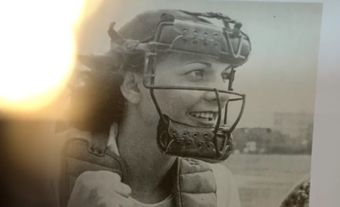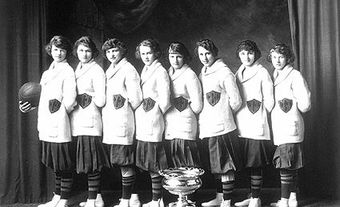The All-American Girls Professional Baseball League (AAGPBL) operated between 1943 and 1954. A total of 68 Canadian women from six provinces signed contracts to play on the circuit. It was later immortalized by the Hollywood movie A League of Their Own (1992). Canadian players were among the best pitchers and hitters in the league. Mary “Bonnie” Baker starred on the field and appeared on the league’s behalf on TV and in magazines. Helen Fox led the league as a pitcher, Eleanor Callow was the league’s all-time best power hitter and Helen (Callaghan) Candaele St. Aubin was known as “the feminine Ted Williams.” The Canadians who played in the AAGPBL were inducted as a group into the Canadian Baseball Hall of Fame and Museum in 1998. Candaele St. Aubin was inducted individually in 2021.

Background and Formation
In 1943, the owner of Major League Baseball’s Chicago Cubs faced a dilemma. Philip K. Wrigley feared the continued conscription of young men into the American war effort might bring about the suspension of MLB play, as had happened to some minor-league teams and leagues. Wrigley, a chewing gum magnate whose name still adorns the Chicago Cubs’ ballpark, wanted to ensure baseball could continue as a business during the Second World War. His solution: organize a league of women softball players.
The All-American Girls Professional Baseball League (AAGPBL) began operating in 1943 with several franchises in Midwestern American cities. It provided a rare chance for women athletes to earn good salaries while playing professionally. The league began as an underhanded-pitching softball league but evolved to sidearm pitching and overhand pitching, with different sized balls.
Many players were signed to contracts after being evaluated by Hub Bishop, a long-time hockey and sports executive from Regina. He served as a Canadian commissioner for the league.
One of the original managers in the league was Johnny Gottselig, a Russian-born hockey player, whose family immigrated to Regina. He played left wing for 16 seasons with the Chicago Blackhawks of the National Hockey League.
Practice sessions for the inaugural season were held at Wrigley Field in Chicago in spring 1943. All 14 Canadians invited gained one of the 60 roster spots available on the four original teams: Rockford (Illinois) Peaches, Kenosha (Wisconsin) Comets, Racine (Wisconsin) Belles and South Bend (Indiana) Blue Sox.

League Rules
While the athletes were keen on displaying their baseball skills, the league mandated they also get instruction on social etiquette, including the application of makeup, during night classes at the Helena Rubenstein’s Beauty Salon.
Each team was assigned a chaperone, and players had to obey strict rules regarding social behaviour and conduct away from the ballpark. The players were told to be “neat and presentable in your appearance and dress, be clean and wholesome in appearance, be polite and considerate in your daily contacts, avoid noisy, rough and raucous talk and actions and be in all respects a truly All-American girl.” There was to be no smoking or drinking alcohol in public; no fraternizing with men without a chaperone present; no wearing uniforms in the stands with the fans; and no wearing slacks off the field. “We were supposed to play like men,” Helen (Callaghan) Candaele St. Aubin once told People magazine, but “look like women.”
For uniforms, the players wore a pastel-coloured, flared and belted tunic one-piece. It had short sleeves and a bodice flap that buttoned on the left side, and a circular team crest on the chest. The players often suffered scrapes and bruises on their exposed legs from sliding on rough dirt infields.
The league’s emphasis on femininity led the sportswriters of the era, almost all of them men, to refer to the circuit as the “Lipstick League” or “Glamour League.” Over the league’s first few seasons, it evolved from using a softball pitched underhand to using a ball slightly larger than a baseball delivered overhand.
Canadian Representation
During the league’s 12 seasons, around 600 women signed contracts to play, including 68 Canadians. Most came from the three Prairie provinces, where top talent was on display in competitive women’s softball circuits. Over the league’s history, 28 players hailed from Saskatchewan, 13 from Manitoba and 10 from Alberta. Softball was well established as a sport at Sunnyside Park in Toronto, so another 10 players came from Ontario. Six players came from British Columbia and only one from Quebec.
The players all had varied backgrounds. They were clerks, teachers, stenographers, farmers and housewives. Some left jobs in wartime industries to play the game they loved. Most were unmarried during their playing days, while some identified as lesbians, though they were unable to marry or acknowledge their relationships under the laws and social mores of the era. (See also Lesbian, Gay, Bisexual and Transgender Rights in Canada.)

Notable Canadians
The most prominent Canadian in the league was Mary “Bonnie” (George) Baker, a catcher from Regina. Her attractiveness and charming demeanour earned her the nickname “Pretty Bonnie Baker.” She was featured in national magazines, including Life and Sport magazines, and appeared as a mystery guest in 1952 on the popular TV show, What’s My Line? Baker also served as a player/manager for the Kalamazoo (Michigan) Lassies in 1950. After retiring as a player, Baker returned to Regina where she was hired as sports director of radio station CKRM. It billed her as Canada’s first woman sportscaster.
Helen (née Nicol) Fox, who was from the Alberta hamlet of Ardley, notched an impressive 31–8 record to help the Kenosha Comets win the league in its inaugural season. She also led the league in several pitching categories, including victories, win percentage (.795), earned-run average (1.81), games pitched (47), innings pitched (348) and strikeouts (220). She was named league pitcher that year. She was pitcher of the year again in the league’s second season, with a 17–11 record and a 0.93 earned-run average.
Fox retired after 10 seasons. She played for the Comets and the Rockford Peaches. She held career league pitching records for games (313), innings pitched (2,382) and strikeouts (1,076). She also led in career wins (163) and losses (118). Her 13 consecutive victories recorded in 1943 went unrivalled.
Helen (Callaghan) Candaele St. Aubin was known as “the feminine Ted Williams” for her hitting prowess. The diminutive athlete, who stood 5-foot-1, 115-pounds (1.55 m, 52 kg), was second in the league in batting average in 1944 and led the league with a .299 average the following season. Her older sister, Margaret (Callaghan) Maxwell, was a teammate for several seasons. One of Helen’s sons, Kelly Candaele, co-produced a 1987 documentary about the league that inspired the Hollywood movie of the same name. Her youngest son, Casey Candaele, had a nine-year MLB career, beginning with the Montreal Expos in 1986. The manager of the Toronto Blue Jays’ AAA affiliate as of 2023, he is the only MLB player whose mother also played professional baseball.
Other accomplished Canadian players in the AAGPBL include Gladys “Terrie” Davis from Toronto, who won the league batting title in the first season with a .332 average; left-handed pitcher Doris Barr, who threw a no-hitter for Racine in 1945, the same season in which she won 20 games; Evie (Wawryshyn) Moroz, a school teacher who hit .266 in 544 career games, including an all-star season in 1950; and Eleanor Callow of Winnipeg, who was the league’s all-time leading power hitter with 60 triples and (55) home runs. Her career 407 runs batted-in (RBI) were third most in league history.
In Popular Culture
The AAGPBL was mostly forgotten following its dissolution until the 1987 documentary by the son of a former player inspired the 1992 Hollywood movie, A League of Their Own, starring Geena Davis, Tom Hanks and Madonna. The popularity of the movie revived interest in the league and its trailblazing athletes. It also inspired a fictional comedy-drama series of the same title in 2022, which explores friendships and love affairs among the players.
In 2020, Netflix released the documentary A Secret Love about the love affair between Terry Donahue, a catcher from Saskatchewan, and Pat Henschel. The women had kept their relationship secret for decades owing to the prejudices of the era.
Honours
Canadians played a prominent role throughout the AAGPBL’s 12-season history, winning honours as batting and pitching champions. In 1998, the Canadian Baseball Hall of Fame and Museum in St. Marys, Ontario, inducted all Canadians in the league as a group. Helen (Callaghan) Candaele St. Aubin earned induction as an individual in 2021. The National Baseball Hall of Fame and Museum in Cooperstown, New York, has a permanent display featuring women in baseball, including some of the Canadians who played in the AAGPBL. Many of the players have also been honoured by municipal and provincial sports’ halls of fame.
The Players
All 68 Canadians honoured by the Canadian Baseball Hall of Fame and Museum with birthplace/hometown. (Original 14 players in bold; maiden name in parentheses.)
- Flora Velma “Abby” Abbott, Regina
- Mary “Bonnie” (George) Baker, Regina
- Barbara Barbaze, Sarnia, Ontario
- Doris “Dodie” Barr, Starbuck, Manitoba
- Christine (Jewett) Beckett, Regina
- Catherine Bennett, Regina
- Ethel “Phoebe” Boyce, Phoenix, BC
- Eleanor “Squirt” (Knudsen) Callow Litterick, Winnipeg
- Muriel Coben, Gelert, Ontario
- Dorothy Cook, St. Catharines, Ontario
- Mary “Penny” “Peanuts” (Marteniuk) O’Brian Cooke, Smoky Lake, Alberta
- Audrey “Dimples” (Haine) Daniels, Winnipeg
- Gladys “Terrie” Davis, Toronto
- Marguerite (Jones) Davis, Regina
- Lena “Lee” (Surkowski) Delmonico, Moose Jaw, Saskatchewan
- Anne (Surkowski) Deyotte, Moose Jaw, Saskatchewan
- Terry Donahue, Melaval, Saskatchewan
- Betty (Carveth) Dunn, Edmonton, Grande Prairie, Alberta
- Julianna “Julie” (Sabo) Dusanko, Regina
- Elsie “Windy” (Wingrove) Earl, Saskatchewan
- June “Venus” Emerson, Moose Jaw, Saskatchewan
- Helen (Nicol) Fox, Ardley, Alberta
- Ruth (Middleton) Gentry, Winnipeg
- Jeanne Gilchrist, New Westminster, BC
- Thelma (Golden) Fidler, Toronto
- Ethel (McCreary) Gould, Regina
- Olga Grant, Calgary
- Marjorie Hanna, Calgary
- Irene Headin, Saskatoon, Saskatchewan
- Lillian Hickey, Vancouver, BC
- Agnes “Aggie” (Zurowski) Holmes, Edenwold, Saskatchewan; Regina
- Thelma (Grambo) Hundeby, Saskatchewan
- Dorothy “Dottie” Hunter, Winnipeg
- Alice Janowski, Sherbrooke, Quebec
- Daisy (Knezovich) Junor, Regina
- Dorothy “Dottie” (Ferguson) Key, Virden, Manitoba
- Mary (Justra) Shastal & Kustra, Winnipeg
- Olive “Ollie” (Bend) Little, Poplar Point, Manitoba
- Martha “Marty” (Rommelaere) Manning, LaFleche, Saskatchewan
- Ruby (Knezovitch) Martz, Regina
- Ruth Mason, Moose Jaw, Saskatchewan
- Margaret (Callaghan) Maxwell, Vancouver
- Mildred “Millie” (Warwick) McAuley, Regina
- Colleen “Smity” (Smith) McCulloch, Vancouver
- Lex McCutchan, Regina
- Kay “Heimie” (Heim) McDaniel, Edmonton
- Anne Jane “Annabelle” (Thompson) McFarlane, Edmonton
- Genevieve “Gene” (George) McFaul, Regina
- Evelyn “Evie” (Wawryshyn) Litwin Moroz, Tyndall, Manitoba
- Doreen “Betty” (Petryna) Allen & Mullins, Liberty, Regina
- Arleene “Johnnie” (Johnson) Noga, Ogema, Saskatchewan
- Vickie Panos, Saskatchewan
- Janet (Anderson) Perkin, Saskatchewan
- Virginia (Carrigy) Piersol, Regina
- Erla Jean (Thomas) Reynolds, Winnipeg
- Lucella “Lu” (MacLean) Ross, Lloydminster, Saskatchewan
- Helen (Nelson) Sandiford, Toronto
- Joan Schatz, Winnipeg
- Yolande “YoYo” (Teillet) Schick, St. Vital, Manitoba
- June “Moneybags” Schofield, Toronto
- Shirley Smith, Toronto
- Helen (Callaghan) Candaele St. Aubin, Vancouver
- Marion (Watson) Stanton, Chatham, Ontario
- Mae Starck, Hamilton, Ontario
- Thelma Walmsley, Sudbury, Ontario
- Elizabeth “Betty” “Bobo” “Wiggles” (Berthiaume) Wicken, Regina
- Hazel (Measner) Wildfong, Saskatchewan
- Dora Doris (Shero) Witiuk, Winnipeg
(See also Women and Sport; The History of Canadian Women in Sport.)

 Share on Facebook
Share on Facebook Share on X
Share on X Share by Email
Share by Email Share on Google Classroom
Share on Google Classroom



